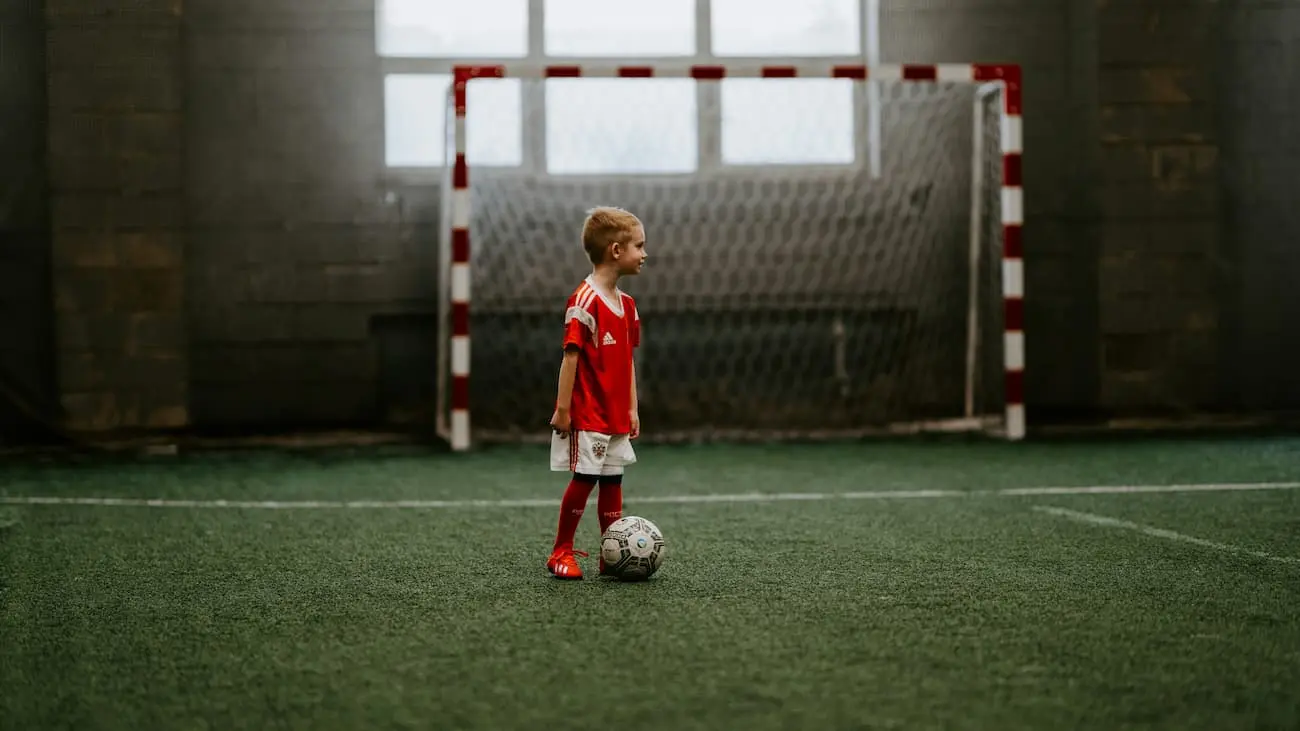NEW FORMS OF MINI FOOTBALL
Thiago Calderaro
The New Game Formats Have Been Decided
From the 2024/25 season, it has been determined for the Munich district that only one game format will be played per age group.
U6: Football 3 Festival, clubs organise themselves as before
U7: Football 3 Festival, clubs organise themselves as before
U8: Football 5 Tournament format, played on 4 mini goals
U9: Football 5 Tournament format, played on small-sided goals with height reduction
U10: Football 5 League operation
U11: Football 7 League operation
The Association's Stance on Kids' Football
Objective of Mini Football: The concept aims to create a platform where children can develop their football skills within a framework that encourages creativity and game intelligence. It seeks to make football accessible to all children, ensure equal playing times for all participants, and provide a positive experience through numerous ball contacts and goals.
Holistic Game Concept: The mini football concept envisions a flexible game format that adapts to the physical development of children. This includes adjustments to the size of the playing field, the number of players, the types of balls, and the goals to enable age-appropriate advancement.
Focus on Individual Development: Unlike traditional approaches that often emphasise results, the focus of mini football is on the individual development of each child. Coaches and trainers are expected to create conditions that allow children to progress at their level without being over- or under-challenged.
The Game Format as a Pedagogical Tool: The concept uses special game formats to encourage children to think and motivate them to learn from mistakes. Through targeted questions and a positive error culture, children are encouraged to find independent solutions and enhance their decision-making ability.
The Role of Coaches and Parents: Coaches and parents play a crucial role in implementing the mini football concept. They are encouraged to create a supportive environment where learning from mistakes and individual development are prioritised.
Benefits of Mini Football: 1. More ball contacts 2. More dribblings 3. More scoring opportunities 4. More goals 5. More passes 6. More playing positions 7. More adjusting 8. More reacting and acting 9. More playing time 10. More fun
Football 3
Organisation:
3 vs. 3: 3 players + rotation player
Played on 4 mini goals (width: 1m to 2m) - the setup can vary
Playing field: Length: approx. 30 metres, Width: approx. 20 metres
Shooting zone (6m from the baseline)
No goalkeeper
Two goals on each side of the playing field - each 2m from the sideline
Goals scored only count within the shooting zone
Playing time: 5 - 8 sections of 5 - 7 minutes each
Game Initiation:
all children stand on the goal line
A coach throws the ball into the playing field from the side. The teams may now start running; the game begins.
Variations are possible (e.g., high ball for two players in the middle or the descending team gets the ball)
Ball Out of Play:
Sideline: Dribble in or kick in outside the shooting zone
Goal out (goal kick): Dribble in or kick in from the goal line
Goal out (corner): Dribble in or kick in from the shooting zone/sideline
Opposing players: 3 metres distance
Scoring:
the successful team retreats to their own half
"Kick-off": Dribble in or kick in from the goal line
Foul:
Free kick: Dribble or shoot
In the shooting zone: Penalty from their own shooting zone; one defender in the shooting zone; all other players stay behind the shooter on the goal line and may only start running when the shooter does.
Referee:
The game is played without a referee. The kids decide themselves.
Special Rules:
Foul in their own shooting zone: 1:1 penalty attack (= Penalty)
3-goal deficit: The losing team increases to 4 players; if this is not possible, the leading team reduces to 2 players.
Coaches:
stand on/at the sideline together with the rotation players
count the goals
pay attention to the rotation
accompany their kids
coach only during game breaks - not during the games
Parents/Fans:
stay outside the official playing field
may cheer but not give instructions
Football 4
Organisation:
4 vs. 4: 4 players + rotation player
Playing field: Length: 25 to 30 metres, Width: 20 to 25 metres
Playing time: 5 - 8 sections of 7 - 10 minutes each
Variant 1:
Played on 4 mini goals – the setup can vary
Shooting zone (6m from the baseline)
No goalkeeper
Goals scored only count within the shooting zone
Variant 2:
Played on 2 small-sided goals – U9: height-reduced goals: 1.65m
Shooting zone: opponent's half
Goals scored only count within the shooting zone
With a goalkeeper (rotation after each game)
Game Initiation:
all children stand on the goal line
A coach throws the ball into the playing field from the side. The teams may now start running; the game begins.
Variations are possible (e.g., high ball for two players in the middle or the descending team gets the ball)
Ball Out of Play:
Sideline: Dribble in or kick in outside the shooting zone
Goal out (goal kick): Dribble in or kick in from the goal line
Goal out (corner): Dribble in or kick in from the shooting zone/sideline
Opposing players: 3 metres distance
Scoring:
the successful team retreats to their own half
"Kick-off": Dribble in or kick in from the goal line
Foul:
Free kick: Dribble or shoot
In the shooting zone: Penalty from their own shooting zone; a defender in the shooting zone; all other players stay behind the shooter on the goal line and may only start running when the shooter does.
Referee:
The game is played without a referee. The kids decide themselves.
Special Rules:
Foul in their own shooting zone: 1:1 penalty attack (= Penalty)
3-goal deficit: The losing team increases to 5 players; if this is not possible, the leading team reduces to 3 players.
Coaches:
stand on/at the sideline together with the rotation players
count the goals
pay attention to the rotation
accompany their kids
coach only during game breaks - not during the games
Parents/Fans:
stay outside the official playing field
may cheer but not give instructions
Football 5
Organisation:
5 vs. 5: 4 field players + 1 goalkeeper + rotation player
Played on 2 small-sided goals
Playing field: Length: approx. 40 metres, Width: approx. 25 metres
Shooting zone: opponent's field half
Goals scored only count in the opponent's half
Playing time: 6 sections of 12 minutes each
Rotation of players every 3 minutes
after each game, a different player becomes the goalkeeper
Game Initiation:
all children stand on the goal line
A coach throws the ball into the playing field from the side. The teams may now start running; the game begins.
Variations are possible (e.g., high ball for two players in the middle)
Ball Out of Play:
Sideline: Dribble in or kick in
Goal out (goal kick): Dribble in or kick in from the goal line
Goal out (corner): Dribble in or kick in from the corner
Opposing players: 3 metres distance
Scoring:
the successful team retreats to their own half
"Kick-off": Dribble in or kick in from the goal line
Foul:
Free kick: Dribble or shoot
In the shooting zone: Penalty from their own shooting zone; a defender in the shooting zone; all other players stay behind the shooter on the goal line and may only start running when the shooter does.
Game Mode:
Champions League mode
Determination of the strongest and weakest field
Winner moves up a field, loser moves down a field
Strongest field: Winner stays
Weakest field: Loser stays
In the event of a draw, the team that scored the last goal moves up
In the case of a 0:0 draw, two players decide by "Rock-Paper-Scissors"
Referee:
The game is played without a referee. The kids decide themselves.
Special rules:
Foul in their own shooting zone: 1:1 penalty attack (= Penalty)
3-goal lead: The leading team reduces to 4 players
Coaches:
stand on/at the sideline together with the rotation players
count the goals
pay attention to the rotation
accompany their kids
coach only during game breaks - not during the games
Parents/Fans:
stay outside the official playing field
may cheer but not give instructions
Football 7
Organisation:
7 vs. 7: 6 field players + 1 goalkeeper + rotation player
Played on 2 small-sided goals
Playing field: Length: approx. 55 metres, Width: approx. 35 metres
Side playing fields in 2vs2 or 3vs3 for non-participating players
League operation: Playing time: 4 quarters of 15 minutes each Rotation of players after 7 minutes and during the break between quarters
Tournament operation (usually with 4 teams) Game duration per game: 2 x 12 minutes Rotation of players after 6 minutes Note: For 3 teams, 2 x 15 minutes; players of the team not playing participate in the side playing field (Playing time 4 x 6 minutes, with rotation)
The game formats 4 vs. 4 and 5 vs. 5 are also possible (rules are shown for younger age groups)
Game Initiation:
all children stand on the goal line/penalty area line
A coach throws the ball into the playing field from the side. The teams may now start running; the game begins.
Alternatively: Kick-off for one team (change at the quarters)
Ball Out of Play:
Sideline: Throw-in
Goal out (goal kick): Goal kick
Goal out (corner): Corner kick
Opposing players: 3 metres distance
Scoring:
the successful team retreats to their own half
"Kick-off": Dribble in or kick in from the goal line or kick-off in the middle
Foul:
Free kick: Dribble or shoot
Referee:
The game can be played without a referee.
Coaches:
stand on the sideline (rotation players play in the side playing fields)
count the goals
accompany their kids
coach only in a few situations
Parents/Fans:
stay outside the official playing field
may cheer but not give instructions
Criticism from the Coach Forums
The new forms of play have been repeatedly criticised by coaches in the community. The reform has been the subject of controversial debate for years, although in my opinion it may be the only correct approach from a purely sporting perspective. It is undisputed that the higher number of ball contacts and faster play due to smaller pitches has a positive influence on technique and cognitive speed in decision-making. With my Brazilian roots, I am a great advocate of futsal and therefore, from a sporting point of view, a great supporter of small sided games.
However, a lot of the criticism is also directed at the organisational aspect. The self-organisation of the weekly festivals and the additional financial burden of procuring mini goals mean extra work compared to simple games. In the special case of the U10s in the Munich district, a considerable number of coaches have criticised the fact that 5v5 will be played in the league starting in the new season. And this criticism is justified, as the smaller number of children on the pitch increases the number of children on the bench while the squad size remains the same. One solution could be to create a second field for bench players. With certain squad sizes, two teams could even be entered for the league, although this could mean a lot of extra logistical work. Will the matches then always take place on the same day and at the same venue one after the other? The association has not yet been able to answer this question.
Source
https://www.bfv.de/bildung-und-foerderung/talente-und-auswahlteams/minifussball-bayern-alle-infos
Continue Reading
This might also interest you:







